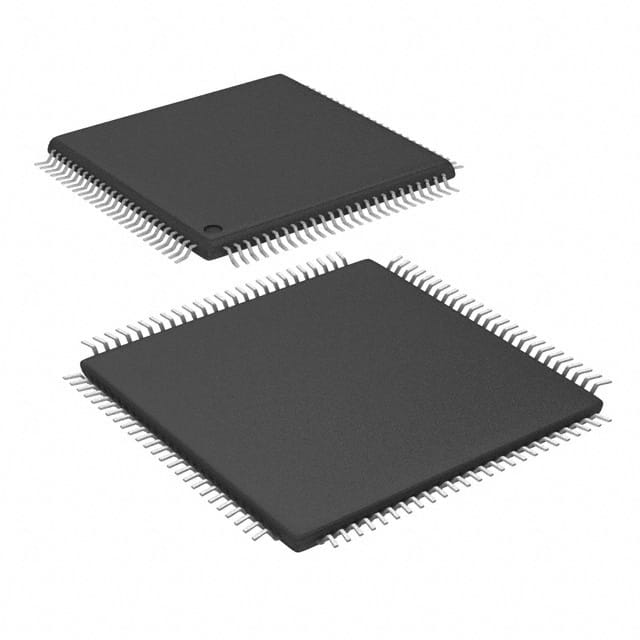Viz Specifikace pro podrobnosti o produktu.

DSPIC33FJ256GP510AT-I/PT
Product Overview
- Category: Microcontroller
- Use: Embedded systems, control applications
- Characteristics: High-performance, low-power consumption, integrated peripherals
- Package: TQFP-44
- Essence: Digital Signal Controller (DSC)
- Packaging/Quantity: Tape and reel, 250 units per reel
Specifications
- Architecture: Modified Harvard architecture
- CPU Speed: Up to 40 MIPS
- Flash Memory: 256 KB
- RAM: 16 KB
- Operating Voltage: 2.5V - 3.6V
- Digital I/O Pins: 35
- Analog Input Pins: 12
- UART: 4
- SPI: 3
- I2C: 2
- PWM Channels: 9
- ADC Resolution: 10-bit
- Temperature Range: -40°C to +85°C
Pin Configuration
The DSPIC33FJ256GP510AT-I/PT microcontroller has a total of 44 pins. The pin configuration is as follows:
- VDD
- VSS
- AN0/RB0
- AN1/RB1
- AN2/RB2
- AN3/RB3
- AN4/RB4
- AN5/RB5
- AN6/RB6
- AN7/RB7
- AN8/RB8
- AN9/RB9
- AN10/RB10
- AN11/RB11
- AN12/RB12
- AN13/RB13
- AN14/RB14
- AN15/RB15
- VCAP
- VSS
- AVDD
- AVSS
- OSC1/CLKI
- OSC2/CLKO
- PGD
- PGC
- MCLR/VPP
- RB0/AN0
- RB1/AN1
- RB2/AN2
- RB3/AN3
- RB4/AN4
- RB5/AN5
- RB6/AN6
- RB7/AN7
- RB8/AN8
- RB9/AN9
- RB10/AN10
- RB11/AN11
- RB12/AN12
- RB13/AN13
- RB14/AN14
- RB15/AN15
- VDD
Functional Features
- High-performance digital signal processing capabilities
- Integrated peripherals for enhanced functionality
- Low-power consumption for energy-efficient applications
- Flexible and versatile architecture for various control applications
- Extensive range of communication interfaces (UART, SPI, I2C)
- Multiple PWM channels for precise motor control
- 10-bit ADC for accurate analog measurements
Advantages and Disadvantages
Advantages: - High-performance processing capabilities - Integrated peripherals reduce external component count - Low-power consumption extends battery life - Versatile architecture supports a wide range of applications - Ample flash memory and RAM for program storage and data handling - Extensive communication interfaces simplify connectivity
Disadvantages: - Limited number of I/O pins may restrict the complexity of projects - Higher cost compared to simpler microcontrollers with fewer features - Steeper learning curve due to advanced functionality
Working Principles
The DSPIC33FJ256GP510AT-I/PT operates on a modified Harvard architecture, combining the benefits of both Harvard and Von Neumann architectures. It features a high-performance CPU capable of executing instructions at up to 40 MIPS. The microcontroller integrates various peripherals such as UART, SPI, I2C, and PWM channels, enabling seamless communication and precise control in embedded systems.
The device utilizes flash memory for program storage and RAM for data handling. It operates within a voltage range of 2.5V to 3.6V and can withstand temperatures ranging from -40°C to +85°C. The DSPIC33FJ256GP510AT-I/PT is designed to provide efficient digital signal processing capabilities while minimizing power consumption.
Detailed Application Field Plans
The DSPIC33FJ256GP510AT-I/PT microcontroller finds applications in various fields, including:
- Industrial automation: Control systems for manufacturing processes, motor control, and robotics.
- Automotive: Engine management systems, electronic power steering, and advanced driver-assistance systems (ADAS).
- Consumer electronics: Home automation, smart appliances, and wearable devices.
Seznam 10 běžných otázek a odpovědí souvisejících s aplikací DSPIC33FJ256GP510AT-I/PT v technických řešeních
What is the maximum operating frequency of DSPIC33FJ256GP510AT-I/PT?
- The maximum operating frequency of DSPIC33FJ256GP510AT-I/PT is 40 MHz.
What are the key features of DSPIC33FJ256GP510AT-I/PT?
- DSPIC33FJ256GP510AT-I/PT features high performance, integrated peripherals, and a wide operating voltage range.
Can DSPIC33FJ256GP510AT-I/PT be used in motor control applications?
- Yes, DSPIC33FJ256GP510AT-I/PT is suitable for motor control applications due to its advanced PWM and motor control peripherals.
What communication interfaces are supported by DSPIC33FJ256GP510AT-I/PT?
- DSPIC33FJ256GP510AT-I/PT supports UART, SPI, and I2C communication interfaces.
Is DSPIC33FJ256GP510AT-I/PT suitable for power supply applications?
- Yes, DSPIC33FJ256GP510AT-I/PT can be used in power supply applications due to its high-speed ADC and PWM capabilities.
Does DSPIC33FJ256GP510AT-I/PT have built-in security features?
- Yes, DSPIC33FJ256GP510AT-I/PT offers security features such as code protection and data EEPROM.
What development tools are available for programming DSPIC33FJ256GP510AT-I/PT?
- Development tools such as MPLAB X IDE and MPLAB XC16 Compiler support programming of DSPIC33FJ256GP510AT-I/PT.
Can DSPIC33FJ256GP510AT-I/PT be used in digital power control applications?
- Yes, DSPIC33FJ256GP510AT-I/PT is suitable for digital power control applications due to its high-resolution PWM and analog-to-digital conversion capabilities.
What are the recommended operating conditions for DSPIC33FJ256GP510AT-I/PT?
- The recommended operating voltage range for DSPIC33FJ256GP510AT-I/PT is 2.5V to 5.5V, with a maximum temperature of 125°C.
Is DSPIC33FJ256GP510AT-I/PT suitable for real-time control applications?
- Yes, DSPIC33FJ256GP510AT-I/PT is well-suited for real-time control applications due to its high-performance CPU and deterministic execution.

